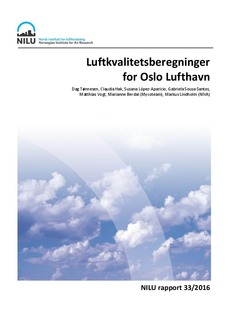| dc.contributor.author | Tønnesen, Dag Arild | |
| dc.contributor.author | Hak, Claudia | |
| dc.contributor.author | Lopez-Aparicio, Susana | |
| dc.contributor.author | Santos, Gabriela Sousa | |
| dc.contributor.author | Vogt, Matthias | |
| dc.contributor.author | Berdal, Marianne | |
| dc.contributor.author | Lindholm, Markus | |
| dc.date.accessioned | 2017-01-25T10:11:44Z | |
| dc.date.available | 2017-01-25T10:11:44Z | |
| dc.date.created | 2016-12-29T12:37:36Z | |
| dc.date.issued | 2016 | |
| dc.identifier.citation | Tønnesen, D., Hak, C., Lopez-Aparicio, S., Santas, G.S., Vogt, M., Berdal, M., & Lindholm, M. (2016). Luftkvalitetsberegninger for Oslo Lufthavn (NILU rapport, 33/2016). Kjeller: NILU. | |
| dc.identifier.isbn | 978-82-425-2864-3 | |
| dc.identifier.issn | 2464-3327 | |
| dc.identifier.uri | http://hdl.handle.net/11250/2428275 | |
| dc.description.abstract | Utslipps- og spredningsberegninger for Oslo Lufthavn i 2016 viser at de største NOX-utslippene kommer fra fly i «take-off»- modus og landingsmodus, men disse utslippene har liten innvirkning på konsentrasjonene i bakkenivå. De høyeste konsentrasjonene av NO2 forekommer inne på flyplassen og er av samme størrelse som i sentrum av middelstore norske byområder. Det største konsentrasjonsbidraget kommer fra flyene. Konsentrasjonen av partikler er i høy grad bestemt av bakgrunnskonsentrasjonen, ikke lokale utslipp fra flyplassen. Forekomst av lukt rundt flyplassen kan forklares ved utslipp av hydrokarboner, der det største utslippet kommer fra fly i taxi-modus. Forekomst av sverting på husfasader er undersøkt, og skyldes hovedsakelig svertesopp. Bruk av avisningsvæske med glykol er den mest sannsynlige årsaken til påvirkning av overflatespenning på ferskvann rundt flyplassen. | nb_NO |
| dc.description.abstract | Modelling of emission and dispersion shows that the largest emissions of NOX are caused by airplanes during take-off and final approach, but these emissions have little impact on ground level concentrations. The highest modelled concentration levels are located within the airport area, and are of similar size as concentrations modelled in central areas of Norwegian medium sized cities. The largest contribution comes from the aircrafts. The concentration of PM is largely decided by the background contribution. Occurrence of odour in the vicinity of the airport can be explained by the emission of hydrocarbons from aircraft in taxi-modes. Occurrence of darkening on house walls in vicinity of and further away from the airport has been investigated. It is mainly caused by growth of fungus. Investigation of possible impact from airport activity on fresh water bodies indicate that the glycol content in the use of de-icing of aircraft has the largest potential impact. | en |
| dc.language.iso | nob | nb_NO |
| dc.publisher | NILU | nb_NO |
| dc.relation.ispartof | NILU rapport | |
| dc.relation.ispartofseries | NILU rapport;33/2016 | |
| dc.title | Luftkvalitetsberegninger for Oslo Lufthavn | nb_NO |
| dc.title.alternative | Air quality calculations for Oslo airport | en |
| dc.type | Research report | nb_NO |
| dc.rights.holder | © NILU – Norsk institutt for luftforskning. Publikasjonen kan siteres fritt med kildeangivelse. | nb_NO |
| dc.source.pagenumber | 82 | nb_NO |
| dc.source.issue | 33/2016 | nb_NO |
| dc.identifier.cristin | 1418071 | |
| cristin.unitcode | 7460,54,0,0 | |
| cristin.unitcode | 7460,57,0,0 | |
| cristin.unitname | By og industri | |
| cristin.unitname | Atmosfære og klima | |
| cristin.ispublished | true | |
| cristin.fulltext | original | |
